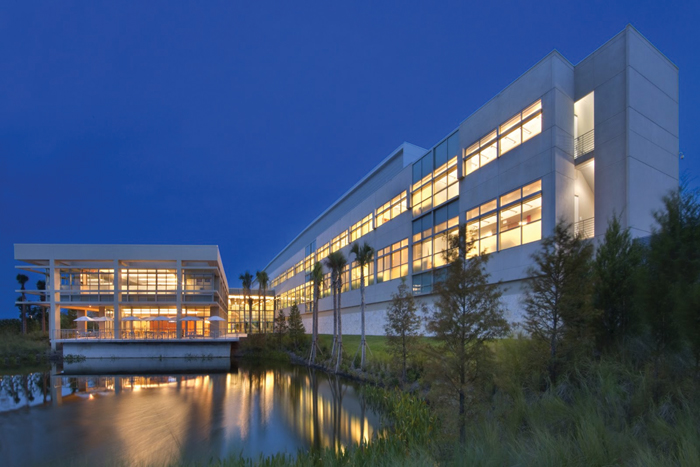
The first major component of Medical City was recently in the news again, when its name was changed to the Sanford Burnham Prebys Medical Discovery Institute following a $100 million donation from San Diego philanthropist Conrad Prebys. Once that facility was underway, it sparked a development boom in and around Lake Nona, which is now a diverse community of neighborhoods, schools, businesses and health-related institutions.
LIVE, WORK, SHOP, PLAY AND LEARN
LAKE NONA IS ORLANDO’S HOTTEST MASTER-PLANNED COMMUNITY, AND MUCH MORE.
By Dana S. Eagles
Lake Nona, long known for its master-planned neighborhoods and research-minded Medical City, is evolving from Orlando’s hottest development into something more: a town where people live, work, shop, play and learn.
While the long-awaited Orlando VA Medical Center gradually opens this year as the last big piece of Medical City, stores, restaurants, offices, laboratories and the nation’s largest tennis center are rising at Lake Nona, which is on the burgeoning east side not far from Orlando International Airport.
Together with new residential options — from single-family homes to apartments and assisted living — the burst of commercial activity is reshaping the 7,000-acre community.
“There’s so much positive energy about what we’re doing,” says Rob Adams, vice president of Tavistock Development Co., which created Lake Nona. “Everybody’s really excited about what Lake Nona can become.”
Adams is especially enthusiastic about the new Town Center, a complex of restaurants, shops and offices that promises to become a common ground for Lake Nona’s 9,000 residents and the professionals in Medical City.
In addition to the new VA hospital, Medical City includes the University of Central Florida College of Medicine, Sanford Burnham Prebys Medical Discovery Institute, University of Florida Research and Academic Center and Nemours Children’s Hospital.
Promoting innovation is a key part of Lake Nona’s design, and it happens “when people of different backgrounds come together,” Adams says. “It comes about in unexpected ways.”
The $75 million first phase of the Town Center, scheduled to open later this year, will have retail and office space, hotel rooms and as many as seven restaurants, says John Pottinger, Tavistock’s director of commercial development. The restaurants have not yet been named. “We’re really trying to be selective in getting some unique restaurants,” Pottinger adds.
Two Marriott hotels — a Courtyard and a Residence Inn − will offer a total of 200 rooms under one roof, and a parking garage for the Town Center will boast an innovative exterior, though details have not been announced.
Plans for future Town Center phases call for more stores and restaurants and a multiplex theater. When complete, the Town Center is expected to encompass more than 1 million square feet of shopping, dining, entertainment and office space.
Fast-Selling Neighborhoods
With the residential growth rates Lake Nona is experiencing, future merchants shouldn’t have a problem finding customers. Lake Nona recorded 278 sales through the first half of 2015, ranking it No. 9 nationally among all master-planned communities, according to Robert Charles Lesser and Company (RCLCO), an Orlando-based real estate consulting firm.
“I really see us as having hit a critical mass a little over a year ago,” he adds. “There are certain neighborhoods that are built out, but with Laureate Park and Somerset Park, we’ve seen a new spark of growth.”
Laureate Park, which is next to Medical City, recently sold its 800th home in 3½ years — but the neighborhood is still only about one-third complete. Billed as a “wired-in, future-evoking” community, Laureate Park offers homes from the mid-$200s to more than $1 million in a variety of styles: townhomes, cottages, urban bungalows and garden homes. The average price is about $400,000, Adams says.
Streets in Laureate Park are named for Nobel Prize winners, and the community offers superfast Internet connections. Yet the exteriors have a bit of a funky retro feel — transitional architecture is the operative term — with rear-load garages and an intriguing color palate.
The community has its own Aquatic Center, and a Village Center, under construction, will offer a restaurant and fitness facility. Builders include Ashton Woods, David Weekley Homes, Minto and Taylor Morrison.
Somerset Park, a gated community on the west side of Lake Nona, has just opened for sales, with 320 lots and prices in the high $200s to $300s. Century Homes and M/I Homes are the builders. As new homes go, Somerset Park’s are more conventional than those in Laureate Park — and that variety is just what the developers had in mind.
“We really want to have a broad offering at Lake Nona,” Adams says.
Lake Nona’s VillageWalk, a development of resort-style homes, is 95 percent built out. But with a new, 144-site VillageWalk section called Enclave, Pulte is offering executive homes starting in the high $500s. Enclave residents will have access to VillageWalk’s fitness facilities and town center.
Rental options are growing at Lake Nona, too. Landon House, a five-story luxury apartment building, with elevators and a parking garage, is under construction near the Town Center. The 280-unit, urban-style project is expected to open early next year. It will join Lake Nona’s Water Mark apartments, which opened in 2013. Two more apartment complexes are planned, Adams says.
Lake Nona will begin serving the special needs of seniors with the opening later this year of Watercrest, a luxurious, 80-unit assisted living and memory-care community. In addition to recreational and cultural programs and assistance with everyday activities, the 76,000-square-foot Watercrest will offer resort-like services and a “coastal living design complete with pool, verandas and outdoor living spaces.”
Although it lies in the southeast corner of the Orlando metro area, Lake Nona is one of the region’s most accessible communities, Adams says, with quick access via State Road 417. “Lake Nona is surprisingly close to downtown Orlando and the tourism corridors,” he notes. “One of the secrets of Lake Nona is that it’s a surprisingly easy commute.”
That accessibility will improve later this year with the completion of a 1.2-mile extension of Lake Nona Boulevard to Boggy Creek Road. The project will give Lake Nona residents and workers a more direct route to the airport and to Osceola County.
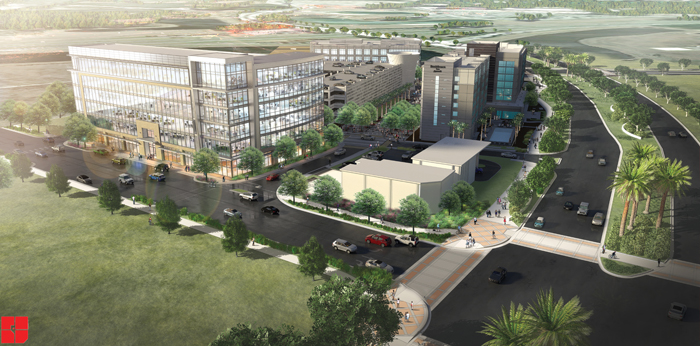
Growing Medical City
Although Lake Nona’s residential options are numerous, the community has always been envisioned as more than a place to live. Medical City’s focus on research, education and treatment has also made Lake Nona a place to work, learn and collaborate with others in the health field.
This year, the last of Medical City’s five major institutions, the Orlando VA Medical Center, is opening in stages, about two years behind schedule. With its soaring, light-flooded atrium, the $620 million hospital is designed to be “a living monument to service,” says VA spokesman Mike Strickler.
It will have 134 in-patient beds and will offer care to more than 100,000 veterans in Central Florida. It also will have what Strickler calls the largest women’s health clinic of any VA hospital — a reflection of the growing emphasis the VA is placing on treating female veterans.
More than 600 people are being hired for the center, says Strickler, who expects employment to reach 2,200 when the hospital is fully operational. The VA center and UCF’s College of Medicine, next door, are working together by offering new doctors a residency in internal medicine at the hospital.
Rising just outside the hospital is SimLEARN, the VA’s National Simulation Center, which will use computer simulation to help train doctors and other health-care providers. Strickler says it’s expected to open next spring.
The new $17 million Gateway Plaza, at Narcoosee Road and Tavistock Lakes Boulevard, provides offices for doctors in both the Florida Hospital and UCF Health medical groups. The UCF Health physicians are College of Medicine faculty members.
Down the road from the VA Medical Center, the $30 million GuideWell Innovation Center is headed toward an opening later this year. Unlike other Medical City buildings devoted to one institution, the Innovation Center is designed to bring health organizations together to solve problems.
The 92,000-square-foot center will accommodate “wet” laboratories, says Pottinger, the commercial development director for Tavistock. The three-story building is named for its main tenant — GuideWell, the “health solutions” company that includes insurer Florida Blue.
According to a statement from Chris Hillier, GuideWell’s senior director of business innovation, the center’s purpose is “to accelerate the change in the health industry from where it stands currently to a ‘new normal’ where high quality goes hand in hand with affordable pricing; where the consumer is no longer a silent partner but the driving force in the market; where technology is a reliable and necessary friend and not an expensive experience that provides no value.
“To do this we will be focused on education, research and collaboration, with partners across the country to identify the best ideas, develop the most useful solutions and take them to the market as fast as possible so that the consumer can afford them, understand their value and in return achieve better health.”
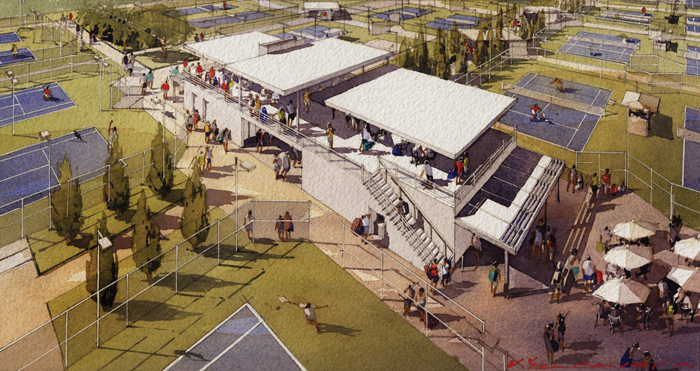
A New Frontier: Sports
A natural extension of Lake Nona’s focus on health is sports development. The Lake Nona Golf & Country Club boasts a championship course designed by Tom Fazio, and now the United States Tennis Association is building what it describes as the “New Home of American Tennis.”
The $60 million USTA National Campus will have more than 100 courts and will offer areas dedicated to players at every level of the game: kids, beginners, collegians, future pros and tour-level pros.
The 63-acre complex, with clay and hard courts, will bring together the association’s Community Tennis and Player Development divisions.
The project began as an effort to find a new home for Player Development, but the search gave the association a chance “to think about reinvention” and create what’s believed to be the nation’s largest tennis center, says Chris Widmaier, USTA’s managing director of corporate communications. Major events at the campus will make it a “win-win” for tennis and Orlando, Widmaier says.
The center will be home to the UCF men’s and women’s varsity tennis teams, and it will be open to the public as well. “As an everyday player, you’ll be going to this nation’s finest tennis center,” Widmaier says.
Tavistock sees the tennis center as the beginning of a larger Lake Nona Sports Innovation and Performance District that could eventually occupy an additional 200 acres, becoming a site for more associations, apparel and equipment companies and sports-technology firms that could collaborate with Medical City researchers.
Widmaier also sees the possibilities. Lake Nona, he says, is “a very dynamic and very exciting location. The potential is unlimited.”
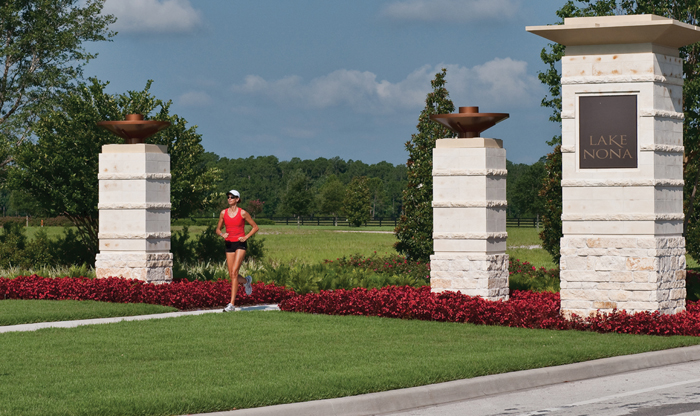
A HOLISTIC APPROACH
WELLNESS IS WOVEN INTO LAKE NONA’S NEIGHBORHOODS.
The emphasis on wellness that permeates Lake Nona’s Medical City doesn’t stop at the doors of the community’s hospitals, colleges and research institutes. It’s also woven into Lake Nona’s neighborhoods, attracting health-conscious homebuyers and giving residents new tools for maintaining body, mind and spirit.
“I think that the way we look at wellness in the community is very holistic because wellness is your physical health, your mental health, your spiritual health,” says Gloria Caulfield, program director of health and wellness for the non-profit Lake Nona Institute, which also focuses on education and sustainability.
The path to wellness at Lake Nona begins with, well, paths. Forty-four miles of trails will make the development “probably the most walkable and bikeable community in the region,” Caulfield says, noting that Lake Nona also organizes running and cycling events.
Long before the first shovelful of dirt was turned for Medical City, Lake Nona developers were emphasizing the connection between fitness and education. The K-5 NorthLake Park Community School, which opened in 1999, shares its campus with the Lake Nona YMCA in an innovative partnership between the Y and Orange County Public Schools intended to encourage family wellness.
Today, wellness programs abound at Lake Nona. Among them is a Lake Nona Institute initiative intended to chart over time the health experiences of those who live or work in the community, turning them into “citizen scientists.”
The Lake Nona Life Project is modeled after the Framingham Heart Study, which started in 1948 in Framingham, Mass. Participants in the long-term Lake Nona study will be asked to take a 30- to 40-minute health survey once a year, Caulfield says. The study is funded primarily by Johnson & Johnson Health & Wellness Solutions, whose Human Performance Institute is located at Lake Nona. Medical City researchers will carry out the study.
In a letter to residents, the Lake Nona Institute wrote that the multigenerational project “will be part of our community’s legacy of sharing what we learn about living well to help future generations live longer, healthier, and happier lives.”
The study could shed new light on wellness and preventable disease, Caulfield says. “We have about 9,000 residents, and we’d like to see about half participate.”
Wellness also will be wired into the Intelligent Home, a showcase home to be built soon in Lake Nona’s Laureate Park. A handful of companies will demonstrate advanced technology designed to enhance residents’ health. Although specifics of the project aren’t final, “we’re looking at the kitchen as a wellness hub for the home,” Caulfield says.
And as if all that weren’t enough to focus attention on health, a tennis complex expected to be the nation’s largest is under construction at the center of Lake Nona.
The $60 million USTA National Campus, the “New Home of American Tennis,” will have more than 100 courts. It will be open for public use in addition to serving as headquarters of the U.S. Tennis Association’s Community Tennis and Player Development divisions. An opening is expected late next year.
Yet one of the most powerful statements Lake Nona makes about wellness has nothing to do with research, technology or sports facilities. It’s actually the opposite of development — a commitment to leave about 40 percent of the community’s 7,000 acres untouched.
As Caulfield sees it, the healthful benefits of green vistas shouldn’t be overlooked. When it comes to wellness at Lake Nona, she says, “the first principle is the environment we created.”
— Dana S. Eagles
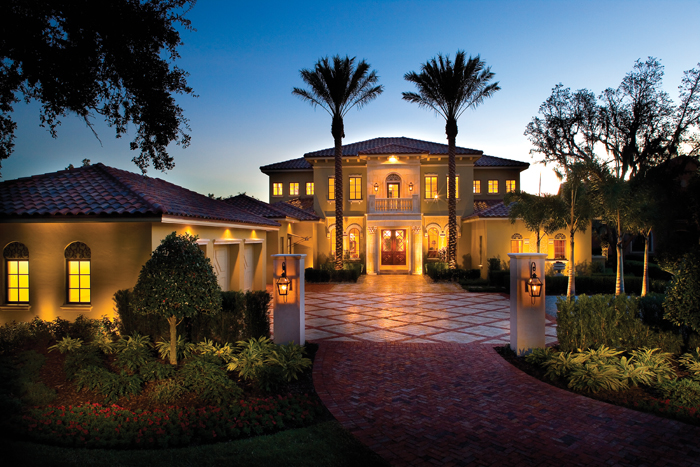
AN ARRAY OF CHOICES
The following neighborhoods are within Lake Nona. Unless otherwise indicated, prices are for single-family homes:
• Lake Nona Golf & Country Club. Private sanctuary of luxurious custom homes surrounded by an array of world-class amenities, including a Tom Fazio-designed championship golf course with a clubhouse and lodge. Homesites priced from $200,000.
• Laureate Park. Featuring homes with modern transitional architectural styles and an abundance of intelligent, forward-thinking components. Builders include Ashton Woods, David Weekley Homes, Minto Communities and Taylor Morrison Homes. Custom-home options are available from Arturo Barcelona Homes, Issa Homes and Way Cool Homes. From the high $230s.
• Somerset Park. Stylish single-family homes in a community featuring such amenities as a community pool and cabana, fountain, playground and walking trails. Builders include M/I Homes and Century Homes. From the $219s.
• VillageWalk. Resort-style neighborhood where streets are connected by bridges that form a walkway to the town center, with conveniences such as a café, salon, post office, bank, gas station and fitness center with a full-time activities director. Amenities include six miles of lighted walking trails, two swimming pools, tennis and basketball courts and a fitness center. Newly opened Enclave at VillageWalk, by Pulte Homes, offers homes from the $500s to more than $1 million.
These neighborhoods are in the Lake Nona area:
• Eagle Creek. Master-planned community surrounded by an 18-hole golf course with a manor-style clubhouse. A village center and on-site elementary school are planned. Builders include Jones Homes USA, Standard Pacific Homes and Toll Brothers. From the $300s, golf villas from the $200s.
• Harmony. A nature-themed master-planned community in Osceola County. Builders include D.R. Horton Homes, Kent Custom Homes, Lennar Homes, Lifestyle Homes, Regatta Building and Development, and Richmond American Homes. From the $190s to more than $600,000.
• North Pointe. Homes feature granite counters and oak or maple cabinetry in kitchens and bathrooms, architectural shingles and stucco exteriors in designer colors. Builders include Lennar Homes, Mattamy Homes and Richmond American Homes. From the mid-$200s.
• Randal Park. 700-acre community that will eventually encompass 815 single-family and 1,400 multifamily homes. More than three miles of bike paths and fitness trails surround a five-acre central park with sports fields. There’s also a community center and eight smaller neighborhood parks and playgrounds. Builders include David Weekley Homes, M/I Homes and Mattamy Homes. From the $250s.
• Tapestry. Gated, 250-acre master-planned community encompassing 1,100 homesites. Amenities will include a clubhouse, cabana, pool, playground and parks. Builders include Beazer Homes, KB Home, Park Square Homes and Mattamy Homes. From the low $200s.
Other new-home communities in the Lake Nona area include the following:
• Avellino (KB Home, from the mid-$200s); Beacon Park (D.R. Horton Homes, from the mid-$200s); Econ Landing (M/I Homes, townhomes from the low $200s); Enclave at Moss Park (Lennar Homes, from the mid-$200s); The Estates at Lake Pointe (M/I Homes, from the $400s); and Lake Pointe at Toho (M/I Homes, from the high $400s).
• Lake Preserve (Meritage Homes, from the mid-$200s); Lakeshore at Narcoosee (Pulte Homes, from the high $190s); Narcoossee Village (M/I Homes, from the mid-$200s); Live Oak Estates (ICI Homes, from the low $500s); North Pointe (Mattamy Homes, from the mid-$200s); Nova Park Estates (Beazer Homes, from the $220s); and Ravinia (townhomes, D.R. Horton Homes, from the mid-$200s).
• Sawgrass Plantation (Beazer Homes, KB Home and Taylor Morrison Homes, from the $200s); Serabella (opening this summer, Mattamy Homes, from the low $200s); Storey Lake (Lennar Homes, from the mid-$200s); Terra Vista (A&M Homes, from the mid-$200s); Turtle Creek (D.R. Horton Homes, from the low $200s); and Stonewood Manor (opening this summer, Century Homes, prices to be announced).
• Underwood Estates (Grand opening, Royal Oak Homes, from the mid-$300s); Waterside Vista (Park Square Homes, from the $400s); and Wyndham Lakes (Lennar Homes, from the mid-$200s, townhomes from the mid-$200s).
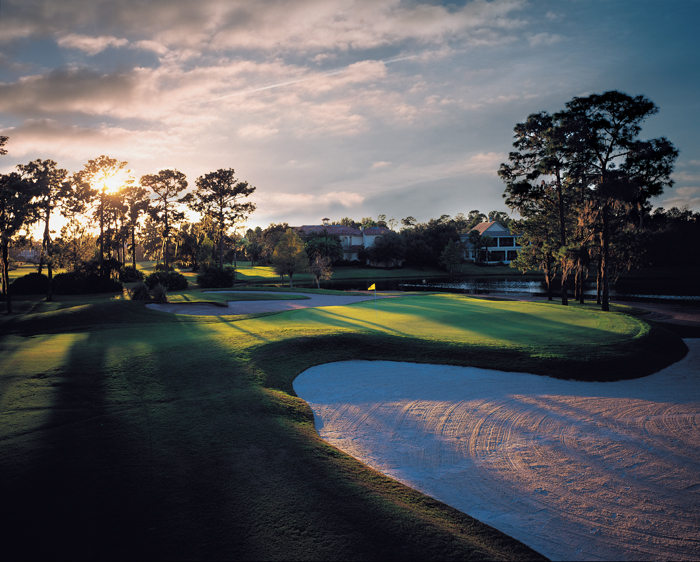
ABOUT LAKE NONA
Orlando’s Lake Nona is one of the fastest-growing communities in America, with more than $2.8 billion in construction across 7.1 million square feet of residential and commercial space. The 11-square-mile, master-planned community is home to a variety of neighborhoods and schools; Lake Nona’s Medical City; a sports innovation and performance district highlighted by the USTA National Campus, the “New Home of American Tennis”; diverse work spaces; recreational facilities; retail centers; and entertainment venues. Lake Nona is committed to sustainable design, healthy living and groundbreaking gigabit fiber-optic technology. Lake Nona, which is adjacent to Orlando International Airport, is planned for more than 5 million square feet of commercial space, 2,200 hotel rooms, 30,000 residents and more than 100 shops and restaurants. Lake Nona was developed by Tavistock Development Co., a diversified real-estate firm owned by Tavistock Group. For more information, visit lakenona.com.
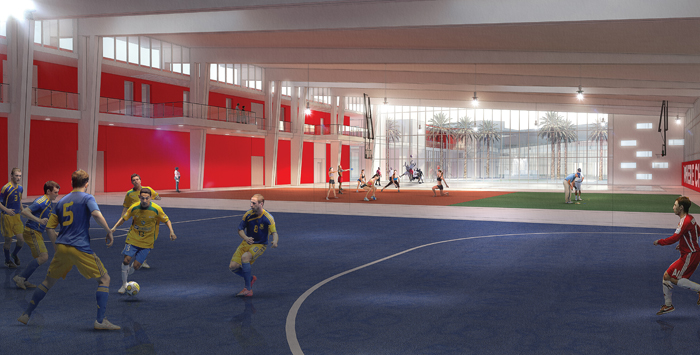
SPORTS AND SUSTANABILITY
Tavistock sees the USTA complex as the beginning of a larger Lake Nona Sports Innovation and Performance District (above) that could eventually occupy an additional 200 acres, becoming a site for more associations, apparel and equipment companies and sports-technology firms that could collaborate with Medical City researchers. Meanwhile, at Lake Nona, sustainability isn’t just a word. Achieving the right balance between the environment and those who live, learn, work and play there is key to making certain the development thrives for generations to come. As part of a Primary Conservation Network, more than 40 percent of Lake Nona has been left as open green space, including conservation areas and enhanced parks with recreational facilities, including 44 miles of paved and unpaved trails. Homes at Lake Nona’s Laureate Park (below) are designed in conjunction with the Environments For Living and GE’s Homes Inspired by Ecomagination programs, which help builders implement energy-efficient construction practices. And during the evening hours, much of Lake Nona is illuminated with energy-saving LED lighting. There’s even a community garden where residents can grow their own veggies.
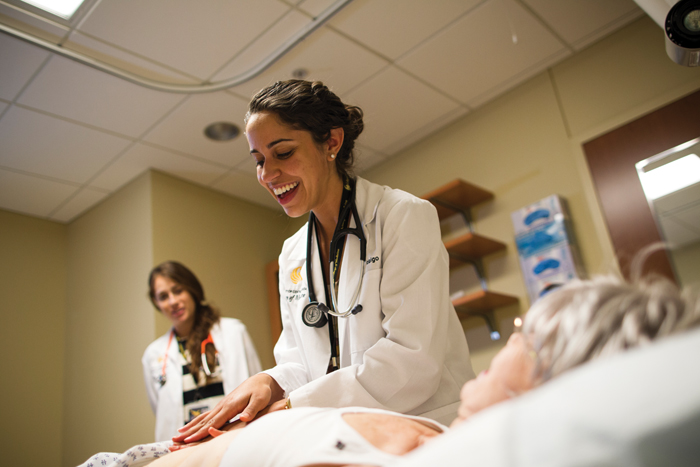
THE CORNERSTONES
HERE ARE FIVE REASONS WHY THEY CALL IT MEDICAL CITY.
Following are the major facilities that anchor Medical City, and an update on what they’re doing now:
• Nemours Children’s Hospital. This 100-bed, 630,000-square-foot hospital was built at a cost of $400 million by the internationally recognized Nemours Children’s Health System and opened in 2012. In Florida, Nemours also owns and operates major pediatric specialty-care centers in Jacksonville and Pensacola, 12 pediatric primary-care centers and six pediatric urgent-care centers. A Ronald McDonald House is under construction next to the hospital. It’s scheduled to open in early 2016 with 15 bedrooms to serve families with ill children being treated at Nemours.
• Sanford Burnham Prebys Medical Discovery Institute. Previously the Sanford-Burnham Medical Research Institute, the $85 million, 175,000-square-foot facility changed its name in June, following a $100 million donation from San Diego-based philanthropist Conrad Prebys. It’s the largest donation ever made by Prebys, and will be used to further implement the institute’s 10-year strategic vision to accelerate the delivery of innovative new treatments that will have a tangible impact on improving human health. Sanford Burnham Prebys opened in 2009 as the first Medical City cornerstone. It encompasses the Diabetes and Obesity Research Center, where scientists focus on metabolic diseases such as diabetes and obesity as well as on Alzheimer’s disease and cancer. The institute’s East Coast campus — the main campus is in LaJolla, Calif. — is also home to the Conrad Prebys Center for Chemical Genomics, where researchers work to identify and develop new medicines.
• University of Central Florida College of Medicine. UCF’s $166 million Health Sciences Campus, which opened in 2010, includes a 170,000-square-foot medical education facility and the 198,000-square-foot Burnett Biomedical Sciences building. Now in its sixth year, the M.D. program boasts 420 students, a tenfold increase from its first year. It has graduated three classes and awarded 169 M.D. degrees. In addition, the college includes almost 3,000 undergraduates and graduate students in the biomedical sciences, including biotechnology, medical laboratory sciences and molecular biology. The medical school also opened an office of UCF Health, its physician practice, this year at Lake Nona. All physicians are College of Medicine faculty members.
• University of Florida Research and Academic Center. The state’s flagship university has built a $53 million, 115,000-square-foot facility that houses its Institute on Aging — a program that studies, among other things, drug interactions in the elderly — as well as the UF College of Pharmacy. The emphasis is on clinical research related to diabetes and cardiovascular disease as well as obesity. Through the UF Institute of Therapeutic Innovation, also at Lake Nona, researchers are conducting trials to help develop new anti-infectious disease drugs.
• Orlando VA Medical Center at Lake Nona. This 1.2-million-square-foot Veterans Administration hospital was dedicated in May and will continue opening in stages throughout 2015. The $620 million facility has 134 in-patient beds; a 120-bed Community Living Center, providing nursing-home care; and a 60-bed domiciliary, providing assisted living and other services to economically disadvantaged veterans. The VA hospital will offer care for more than 100,000 veterans in Central Florida, and the adjacent National Simulation Center, under construction, will train health-care providers using the latest simulation technology. The medical center is also home to Central Florida Veterans Memorial Park, a $3 million memorial built with donations.
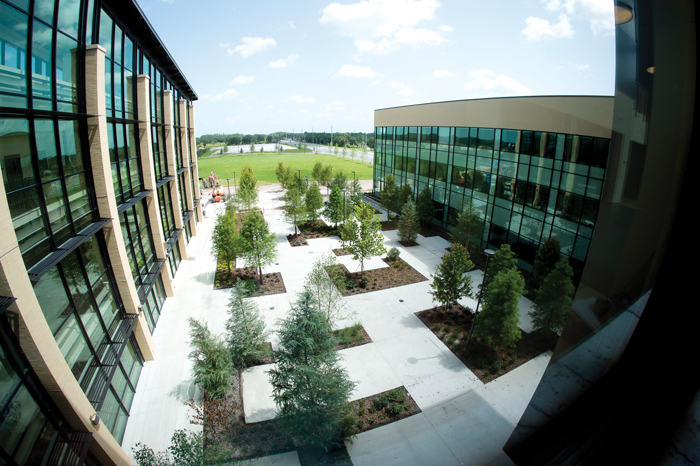
LEARNING FOR LIFE AT VALENCIA
Valencia College’s Lake Nona campus, which opened in 2012, is an ideal place to train for careers in the life sciences. After all, it’s located squarely in the heart of the country’s most dynamic biomedical cluster. The three-story, 83,000 square-foot building replaced shared space at nearby Lake Nona High School. Eventually, the campus will consist of four buildings. There are 18 “smart” classrooms, six science labs — including a biotech lab — a library, a bookstore, a small café and student services offices. Sitting areas are designed to encourage studying in groups, catching up with friends or just contemplating the third-floor view of Lake Whippoorwill. Students can earn traditional associate degrees at the Lake Nona campus, but the primary focus is on math and science. A new Associate in Science degree in biotechnology debuted last year, while programs in physical and occupational therapy are also planned. Built at a cost of $21.7 million by the design-build team of SchenkelShultz Architecture and PPI Construction, the Lake Nona campus boasts such environmentally friendly features as energy saving lights and air conditioning, reflective roofing materials and native landscaping that requires very little piped irrigation.
MILESTONES
MAY 2009
Sanford-Burnham Medical Research Institute opens its East Coast facility at Lake Nona. Cost, $85 million; size, 175,000 square feet; staff, 300.
AUGUST 2010
The UCF College of Medicine opens a 50-acre Health Sciences campus. Cost, $166 million; size, 368,000 square feet; staff, 400.
JANUARY 2012
UCF’s trustees vote unanimously to purchase 25 acres in Medical City near the UCF College of Medicine for a future teaching hospital and clinic.
AUGUST 2012
The University of Florida Research and Academic Center, which houses its doctoral pharmacy program and drug development center, opens. Cost, $42 million; size, 100,000 square feet; staff, 120.
OCTOBER 2012
Nemours Children’s Hospital opens and begins accepting patients. Cost, $397 million; size, 630,000 square feet; staff, 1,000.
MAY 2013
The charter class of students at the UCF College of Medicine graduates. The 36 new doctors all had received full-ride, four-year scholarships courtesy of community donors.
APRIL 2015
The United States Tennis Association breaks ground on its USTA National Campus, the “New Home of American Tennis.” It will feature more than 100 courts and accommodate the association’s Community Tennis and Player Development divisions, among other operations. Cost, $60 million; size, 63 acres; staff, about 150. Opening is planned for late 2016.
MAY 2015
The Veterans Administration dedicates the Orlando VA Medical Center at Lake Nona, a 134-bed facility that will serve veterans throughout Central Florida. Cost, $620 million; size, 1.2 million square feet; staff, about 2,200 at completion. The center will continue to open in stages throughout 2015.
JUNE 2015
San-Diego philanthropist Conrad Prebys gives a $100 million gift to the Sanford-Burnham Medical Research Institute. The institution changes its name to the Sanford Burnham Prebys Medical Discovery Institute.
LATE 2015
The Lake Nona Town Center and GuideWell Innovation Center are scheduled to open. The first phase of the Town Center will feature offices, retail space, restaurants and a parking garage adjacent to Medical City. The three-story GuideWell building, named for its anchor, will provide office and lab space at Medical City for life sciences, health innovation and technology companies.
